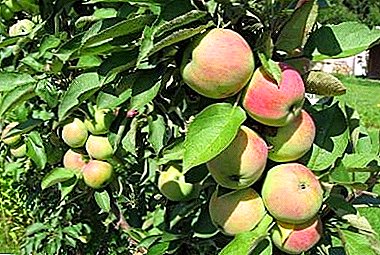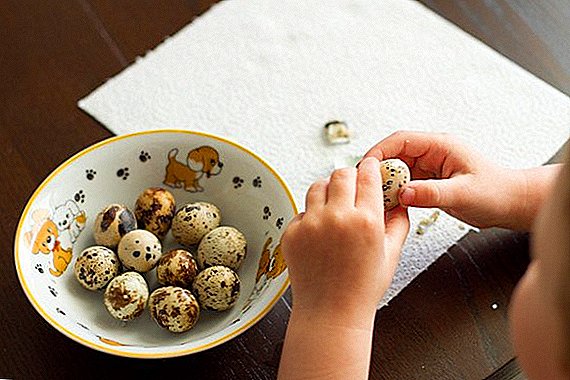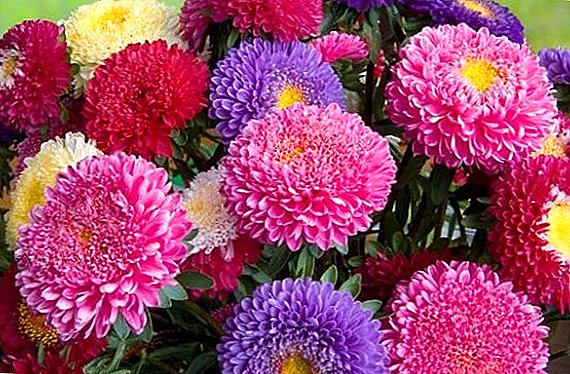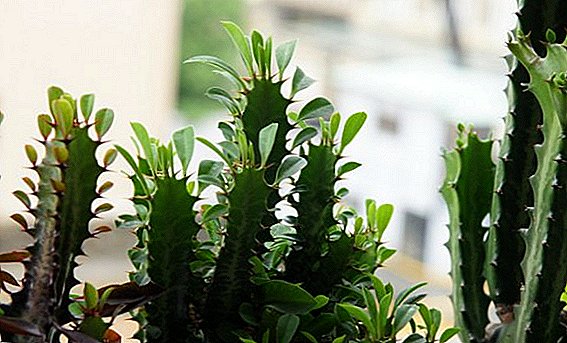 Houseplants may have a different appearance and please their owners, not only for the beautiful flowering or smells. Many flowers just grow, without attracting attention, and they are also in demand at the room growers. Triangular Euphorbia is one of such inconspicuous, but original inhabitants of the window sill.
Houseplants may have a different appearance and please their owners, not only for the beautiful flowering or smells. Many flowers just grow, without attracting attention, and they are also in demand at the room growers. Triangular Euphorbia is one of such inconspicuous, but original inhabitants of the window sill.
Plant characteristic
The stem succulent of the Euphorbia family, resembling a pedestal, music stand, or candelabrum, comes from American, African, and Madagascar subtropical zones. The plant is extremely unpretentious and has a clearly defined original triangular structure. Received its description in the international classification back in 1768.
Important! When growing this plant, it is necessary to remember: as with all its relatives, the milky juice of the triangular euphorbia is poisonous.
From the fleshy, often stiffened trunk, grow dark green shoots with a triangular cross-section. Small drop-shaped leaves grow from their upper parts. At home, flowering occurs very rarely. It is weakly expressed in the form of the acquisition by the leaves at the top of the stems of pink, lilac or purple color. Growth bush can reach 2-3 m and more. 
Useful properties and harm
The positive properties of the plant are as follows:
- Excellent external data - like some other euphorbia, their triangular fellow is very handsome.
- Use near the computer - Many users, following the ancient stereotype about the benefits of fleshy prickly succulent, set the pot in close proximity to a computer or monitor. But spurge is not a cactus at all (the advantage of finding the latter near a computer is also controversial), although a slender and strict plant located near a computer is able to adjust to the working mode.
- Healing abilities - in ancient medicine (for example, in Indian), the powder from the root was a panacea after a snake bite, and the milky juice was used for warts, herpes, parasites.
Did you know? Milky juice of high euphorbia in some African peoples was used in medicine. The liquid was mixed with honey and served as a good laxative.
If the defeat of the integument still occurred, it is necessary to immediately wash the affected areas with warm running water and lubricate them with an ointment based on glucocorticoid hormones. The most common drug of this group is Hydrocortisone. Of the ointments with a stronger effect, you can apply Prednisolone. 
Conditions for growing at home
The question of whether this kind of milkweed can be kept at home has only one answer - it’s necessary. At home, it is unlikely to bloom, but with good care it will develop, strive upwards and become a beautiful tall bush.
Lighting
This light-loving plant should be placed on the southern or southeastern window sills, where it can get the highest daily rate of light. In summer, the pot can be placed in the courtyard under the muffled rays of the sun - under a canopy of agro-grid, awning, sparse canopy of trees, the high visor of the building.
Find out what the benefits and harm of milkweed.
In winter, the southern succulent must provide a long light day. This is done using fluorescent lamps or their LED counterparts. Incandescent lamps should not be used - they consume a large amount of electricity and produce heat, which is unevenly distributed, and a large plant or several bushes will not exactly warm. 
Temperature conditions
The thermophilia of euphorbia is caused by its natural conditions of growth. In the realities of the room, the plant has long shown that it is comfortable in a relative coolness, where it is not necessary to experience extreme temperatures. At home, the bush will be pleased with the coolness of the summer, when the temperature occasionally rises above + 25 ° C. More hot periods are allowed, but the flower will already feel "not at ease". In winter, the plant falls into a kind of hibernation. At this time, the ambient air temperature within + 15 ... + 18 ° С will suit him.
Important! During the heating season, it is better to remove the pot with the bush resting away from the heating devices, so as not to make the ward temperature shock.
Air humidity
It is possible and necessary to ventilate the room - the flow of fresh air invigorates the plant. However, this should be done so that the drafts are away from the bush. Triangular euphorbia is undemanding of humidity in the room, so it normally maintains a dry atmosphere.
But he does not like dust on his stems and leaves, so 1-2 times a month it is worth spraying the plant with warm water or washing it under a soft shower. At the same time, so that dust and debris do not fall under the stem, the soil around it is covered with a film, which after the procedure is carefully removed. 
How to care for a plant at home
In the room, euphorbia feels great; therefore, care for it consists of simple procedures:
- watering;
- fertilizer;
- transfer.
Watering
Considering that the plant is a succulent and is able to accumulate moisture in its organs, it is necessary to water it rarely and carefully. Winter watering is reduced to moisten the soil around the bush once a month to prevent root rot. In the summer, water is supplied under the main stem once a week in moderation.
Check out the varieties of milkweed.
To control moisture, a clod of earth is inspected in which the bush grows. If the upper dry layer just below its soil is wet, it is too early to water. Otherwise, you need to water the flower with warm soft neutral (separated) water.
Top dressing
From the beginning of spring to mid-autumn, once a month a complex mineral supplement for cacti and succulents is introduced into the soil. It is possible to use the compositions intended for usual houseplants, but they should be diluted by third or half with water. In winter, the plant does not need to be disturbed - it rests in the spring to look even more beautiful than last year. 
Transfer
Young bush transplanted annually by transshipment. The roots in such a period grow very quickly, so you should not overdo the spurge in the old pot, from which it has already grown. As they grow up, the transplant is carried out less frequently - once every 2-3 years, and the pot is chosen not one, but two more sizes. The change of "place of residence" is made in the middle of spring, when the plant has not yet fully shifted to the active stage of growth after winter dormancy.
At the bottom of the pot must be placed drainage. For this purpose, small pebbles, vermiculite, or their mixture is used. Given that this succulent root system is superficial, then you need to lay a couple of stones at the bottom of the pot to give stability. When transplanting it is best to use a new soil mixture, purchased in a store or made independently.
Did you know? Euphorbia, which grows in our latitudes, in ancient times was called "demon milk". If it gets into the eyes, its juice can lead to total blindness.
A normal soil for this type is considered to be a mixture of the following components in the same proportions:
- leaf earth;
- turf ground;
- peat;
- sand.

How to propagate spurge
To get a new plant is very simple - for this you need to know how to root a side shoot or how to propagate using a cutting. Both methods are productive and are applied in spring or early summer.
Side shoots
For breeding euphorbia triangular using side shoots need to do the following manipulations:
- Cut off the side shoot with a sharp thin knife (a stationery paper knife will work well).
- Dry it for 2-3 days, wrapping the cut in natural fabric.
- Land a sprout in a wet sand tank, observing that the soil does not dry out.
- Protect the seedling from sunlight before rooting.
- When the sprout has given several roots, you can rearrange the container in a well-lit place.
Also read about how to care for succulents at home.
Cuttings
Cutting is carried out in this way:
- Cut from the tops of the most healthy triangular stems of cuttings 8-10 cm long.
- Gently rinse the cut sites with warm water.
- Dry the cuttings for 2-3 days.
- Before planting, sprinkle with activated carbon powder for disinfection and better drying.
- Plant the stalks into a nutrient substrate for cacti.
- After the appearance of several roots, transplant the seedlings into their first pots.

Growing problems
With proper care, this plant does not cause problems to their owners. Diseases and pests almost do not bother euphorbia triangular, subject to the rules of irrigation, normal humidity and light. But if the bush did not like something, then it can get sick.
You will be interested to know how to care for euphorbia Mil and Pallas.
The signs of ailments are as follows:
- Dropping leaves - check the drainage and soil moisture: it is possible that the spurgeon was getting excess moisture or the water was retained in the clogged drainage.
- Woody growths on the trunk - appear due to sunburn, which will pass independently when moving to a less bright place or shading.
- Yellowing foliage - the cause may be overfeeding with fertilizers or their lack during the period of increased growth.
Pests bypass the euphorbia, because it is possible to get poisoned on its bushes. Some insects that do not penetrate into the succulent pulp can do some harm. The spider mite is able to weave its threads, and the mealybug manifests itself as the formation of a white plaque in the upper part of the plant. All of these scourges are treated by washing with a soap solution or spraying the affected areas with a diluted insecticide (for example, Aktara).  Euphorbia are both fragile, creeping on the ground, and majestic, rising high to the sky. Each of them has its own energy, including a triangular form, which is able to decorate a room in the form of a resident of the window sill, and in the floor pot.
Euphorbia are both fragile, creeping on the ground, and majestic, rising high to the sky. Each of them has its own energy, including a triangular form, which is able to decorate a room in the form of a resident of the window sill, and in the floor pot.












